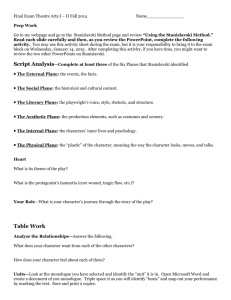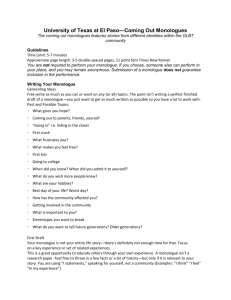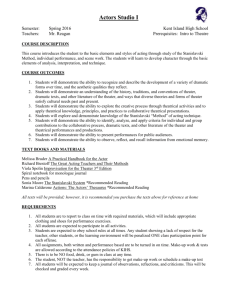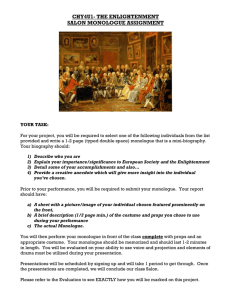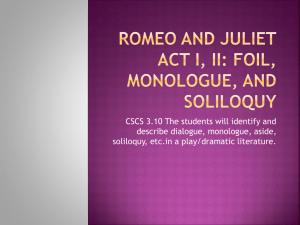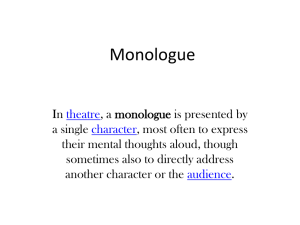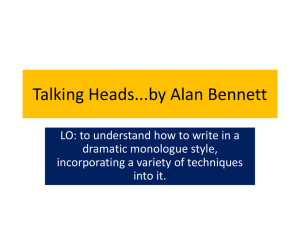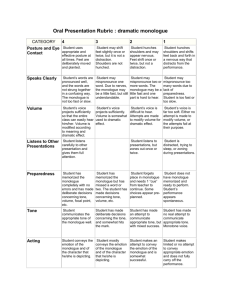Table Work
advertisement
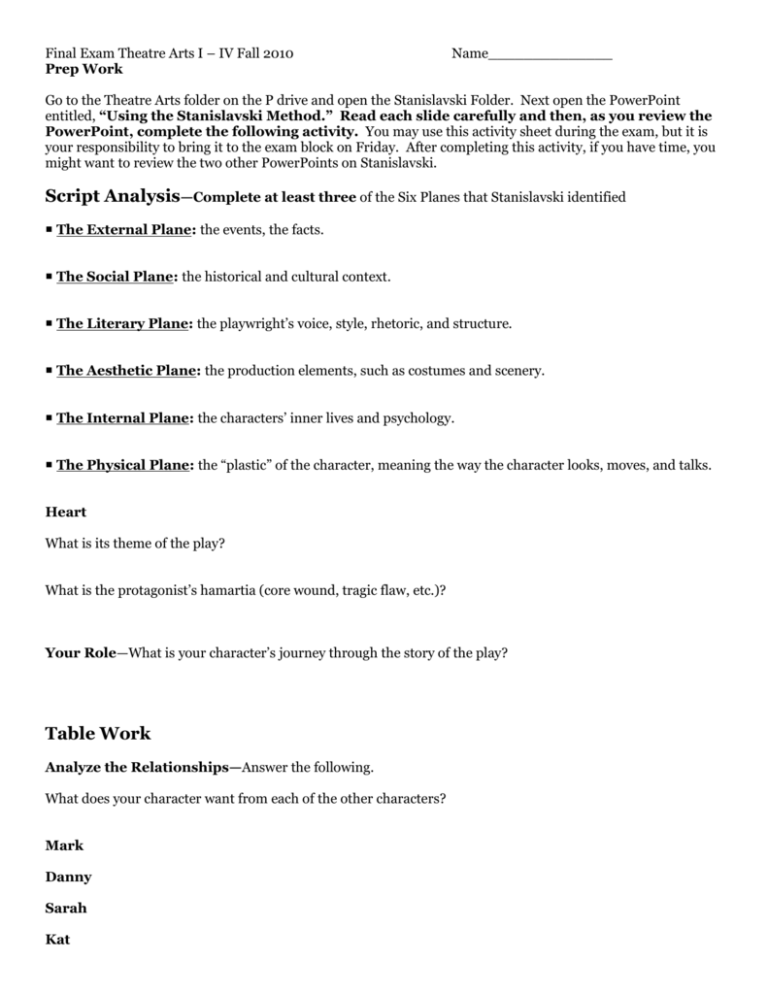
Final Exam Theatre Arts I – IV Fall 2010 Prep Work Name______________ Go to the Theatre Arts folder on the P drive and open the Stanislavski Folder. Next open the PowerPoint entitled, “Using the Stanislavski Method.” Read each slide carefully and then, as you review the PowerPoint, complete the following activity. You may use this activity sheet during the exam, but it is your responsibility to bring it to the exam block on Friday. After completing this activity, if you have time, you might want to review the two other PowerPoints on Stanislavski. Script Analysis—Complete at least three of the Six Planes that Stanislavski identified The External Plane: the events, the facts. The Social Plane: the historical and cultural context. The Literary Plane: the playwright’s voice, style, rhetoric, and structure. The Aesthetic Plane: the production elements, such as costumes and scenery. The Internal Plane: the characters’ inner lives and psychology. The Physical Plane: the “plastic” of the character, meaning the way the character looks, moves, and talks. Heart What is its theme of the play? What is the protagonist’s hamartia (core wound, tragic flaw, etc.)? Your Role—What is your character’s journey through the story of the play? Table Work Analyze the Relationships—Answer the following. What does your character want from each of the other characters? Mark Danny Sarah Kat How does your character feel about each of them? Mark Danny Sarah Kat Units—Look at the monologue you have selected and identify the “unit” it is in. Open Microsoft Word and create a document of you monologue. Triple space it as you will identify “beats” and map out your performance by marking the text. Save and print 2 copies. On Thursday we will look at: Units, Beats, Follow the Leader, & Transition Character Work Given Circumstances—Identify your character’s: social class, family dynamics, social dynamics, education, wealth, manners, philosophy, religiosity, relationships, personal history, gender, race, sexuality, personality, present emotional state, etc… by discussing the Given Circumstances in a “Freewrite” paragraph. Voice--You must give the lines shadings, nuances, mood, coloration, emotional reality, and energy, all of which should ideally arise organically—not mechanically—by means of precisely setting up the framework in your mind. Do this by finding the right moment-to-moment “if.” Play with your monologue by delivering the lines so that you experiment with several of the above techniques until you find the right moment-to-moment “if.” Plasticity of Movement--Part of your job is to embody the physical life of the character, including his/her posture, gait, use of gesture, expression, eye contact, and general movement styles. In a “Freewrite” paragraph, write what you see as your character’s movement including the aspects listed above. Inside/Outside—Be sure that as you go through the process of preparing for your performance that you develop both the inside & outside simultaneously and don’t fall into the trap of focusing on only one. The Paradox—The Paradox relates to experimenting with the “Magic ‘If.’” As you find the “truth” in your character also experiment with “jamming” or “improvising” like jazz magicians do. Although much of your preparation is about analyzing and then executing your character on the stage, it also is amount making choices at the time, being comfortable enough with your analysis that you are willing to take risks on the stage. Putting It on Its Feet Entrance--Before you enter, you should know where you have just been, what were the conditions of this previous space, what you have just been doing, why are you coming into this new space, what is this new space, and what do you immediately want as you enter? Make and entrance, don’t just go to the center of the stage and begin…think about the above questions. Blocking-- Blocking should be purposeful—not decorative or separate from the intentions of the characters. List your initial thoughts on blocking your monologue. How will you use the space? Will you use levels? Stage Business--Stage Business can help give the actor a way to enter into the reality of the scene. Using the principle of Spheres of Concentration, you can first find the reality of stirring a pot, going through a stack of mail, setting the table, and then expand outward to the larger, more challenging realities of the scene. “Spheres of Concentration” Some things need a wide focus and some things need a narrow focus. The circle of concentration must expand or contract as necessary. For example, threading a needle on stage generally requires a very tiny, narrow circle of concentration. A five-on-one sword fight, in contrast, necessitates a much larger circle of concentration. Identify your “spheres of concentration” in your monologue & think about how you can incorporate stage business. Draw To the Opposite--Look for opportunities for villains to be charming and heroes to be wicked, etc… For example, instead of screaming the line, “I’m going to kill you,” what would happen if it was whispered? Look carefully at your monologue for opportunities to “Draw To the Opposite.” Memorization--Begin to memorize the words and blocking in concert, as they are inseparable. Another memorization technique is to write your monologue as if it were a letter, diary entry, message in a bottle, or list. Refining Basic Tools--Use sense memory and affective memory efforts to recreate and fully inhabit the reality of each beat of the text. The term “sense memory” is used in two very different ways. In the first way, it involves the interaction of the senses and the memory, and the ways in which certain sensory stimuli can trigger memories. People may also evoke the concept of sense memory in the context of an acting technique known as affective memory, in which actors attempt to use their senses to put themselves into the mindset of their characters. Researchers who work with memory have learned that the five senses can play a very significant role in the process of making, storing, and retrieving memories. Smell in particular is very evocative, as the olfactory bulb is located right next to the part of the brain that handles memory storage, so people tend to create strong links between smells and particular memories. Many people have strong associations with a huge variety of smells, ranging from “my grandmother's house” to “that one really good meal,” and smell is sometimes used in marketing to recall such memories and encourage people to buy things. The senses of touch, hearing, sight, and taste can also play a role in sense memory, although these senses are not as directly as involved as the sense of smell. If you close your eyes for a moment, you may be able to visualize the inside of your kitchen, remember what it feels like to pet an animal, evoke the taste of a piece of fruit, or recall a particular chord in a favorite song. In these cases, the sensational experience is stored in the mind along with the memory of the event. Within the realm of acting theory, people use “sense memory” to talk about recalling memories which can be used to more fully inhabit a character on stage. For example, when an actor wants to get into the mood for a sad scene, he or she might use sense memory to reconstruct a funeral or other sad event. Rather than just acting sad, the actor momentarily is sad as he or she remembers the sound of the rain on umbrellas, the feel of a clot of earth, and the smell of lilies around the grave. (http://www.wisegeek.com/what-is-sensememory.htm) Examine your monologue and your own life and see if you can connect to a “sense memory” that would help to reveal the true emotion in your selection. Journey of the Character--Take into account what happens to the characters before the play begins—the backstory. Create a backstory for your character. Explore Relationships Further-- Does the character succeed in getting what he or she wants from the other character(s) in each beat? Explain. Deepening Motivation—Examine your characters “subtext” of unconscious motivations and ambivalences. Re-Score Rhythm & Tempo Perform
